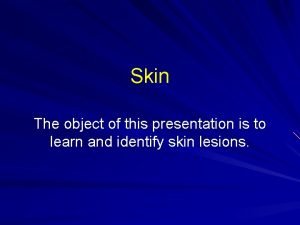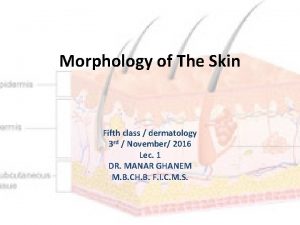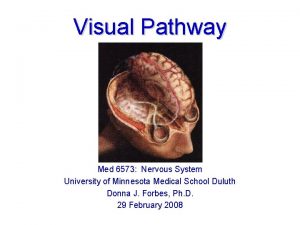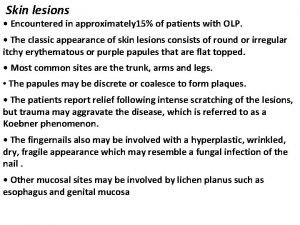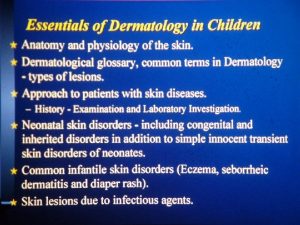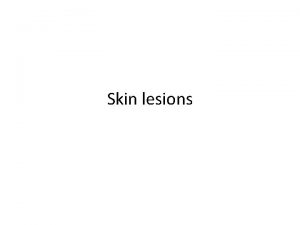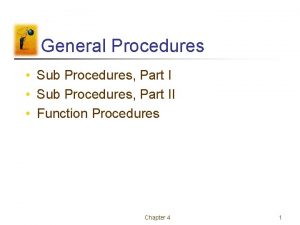Description of Lesions 1800 Introduction to Clinical Procedures





















- Slides: 21

Description of Lesions 1800 Introduction to Clinical Procedures Tiffany Baggs, RDH, BASDH

Lesions of all kinds Elevated Lesions Depressed Lesions Flat Soft Tissue Lesions All lesions: Single or Multiple Wilkins page 151 -156

Elevated Lesions Blisterform: Vesicle: fluid filled, soft and translucent small 1 cm or less, serum or mucin Pustule: any size, pus, yellowish Bulla: large 1 cm or more, serum or mucin, blood

Elevated Lesions Nonblisterform: Plaque: solid lesion, no fluid, firm “pasted on appearance” Papule: small, solid, pointed, rounded or flat topped, Nodule: larger than a papule greater than 5 mm less than 1 cm Tumor: 2 cm or greater, general swelling or enlargement

Papules, Nodules, Tumors Take note of the base of lesion Pedunculated: attached to narrow stalk Sessile: base as wide as lesion

Depressed Lesions Below the level of the skin or mucosa Ulcer: loss of continuity of the epithelium, gray to yellow, surrounded by red Erosion: shallow, depressed lesion that does not extend through the epithelium Regular / Irregular Outline Smooth / Raised Margin Superficial / Deep

Flat Lesions or macule Single macule or Mulitiple macules Regular / Irregular

Other Descriptions Crust Erythema Exophytic Indurated Papillary Petechiae Pseudomembrane Polyp Punctuate Torus Verrucous

Oral Cancer Any patient Red flag: Tobacco use Alcohol use Sun exposure

Discovery- the earlier the better Head, Neck, Oral Examination Every appointment/Document Common site Floor of the mouth Tongue lateral border Lower lip Soft Palate (gingiva, buccal mucosa, oropharynx) Self-examination for Patients

Many forms White areas Red Areas Ulcers Masses Pigmentation

Area to be watched, documented If area does not change/heal, what do we do?

Return in two weeks Biopsy: removal and examinations of a sections of tissue Cytologic smear: surface cells are removed Not biopsied- patient refuses biopsy Referral out for biopsy: dermatologist, oral surgeon Exfoliative cytology

Oral Cancer Detections Systems Velscope Vizi. Lite

Velscope http: //velscope. com/about_velscope/ Cordless, portable and rechargeable: “ring of light” illumination healthy cells in the mouth fluoresce= emitting a bright green glow Unhealthy cells , lack of fluorescence= appearing dark when viewed against the healthy tissue.

Vizi. Lite http: //www. zila. com/40/VIZILITE%26 REG%3 B%20 PLUS/ slightly desicates the cells to make the nuclei more prominent, more visible low intensity light from the handheld light source is reflected off of these abnormal cells down to the basement membrane where the nuclei have been rendered more prominent, and appear to "glow" – making abnormal cells easier to see. Mouthrinse, dyes Patient rinses with a solution for 1 minute, expectorates, lights are dimmed or special glasses used, handheld light stick is used Suspicious areas turn a blue color

Documentation (A, B, C, D, &T) Anatomic location Border Color, patter? Diameter/dimension demarcated? Regular or irregular? Color change configuration where is it? Irregular, oblong: length x width Circular: diameter Type Flat Elevated Fluid filled Loss of skin/mucosa

Documentation Have a baseline Note what kind of lesion Follow up appointments- note any changes For legal purposes be as detailed as possible.

Teach Patient Self examination Diet, nutritional effects on health Oral health tends to reflect general health

Warning Signs of Oral Cancer Swelling, lump, or growth – with or without pain White scaly patches Red velvety areas Sores that do not heal in 2 weeks Numbness, tingling Excessive dryness or wetness Hoarseness, sore throat, persistent coughing or feeling of “lump in the throat” Difficulty swallowing Difficulty in opening the mouth

 Pie in the sky lesion
Pie in the sky lesion Pyramidal vs extrapyramidal lesions
Pyramidal vs extrapyramidal lesions Describing skin lesions
Describing skin lesions Esophagus
Esophagus Primary and secondary lesions of skin
Primary and secondary lesions of skin Olneys lesions
Olneys lesions Extrapyramidal tract function
Extrapyramidal tract function Mount and hume classification
Mount and hume classification Nature lésions
Nature lésions Classification of white lesions of oral cavity
Classification of white lesions of oral cavity Don't touch lesions
Don't touch lesions Glossopharyngeal lesion
Glossopharyngeal lesion Chapter 17 oral pathology short answer questions
Chapter 17 oral pathology short answer questions It projektov�� mana����r
It projektov�� mana����r Scattered white matter lesions
Scattered white matter lesions Daughter mother grandmother pancreatic lesions
Daughter mother grandmother pancreatic lesions Acute and chronic apical periodontitis
Acute and chronic apical periodontitis Med
Med Convergence insufficiency athens
Convergence insufficiency athens Site:slidetodoc.com
Site:slidetodoc.com Lésions
Lésions Vesiculobullous lesions
Vesiculobullous lesions


